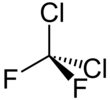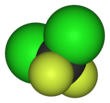Dichlorodifluoromethane
| |||
| Names | |||
|---|---|---|---|
| Preferred IUPAC name
Dichlorodi(fluoro)methane | |||
Other names
| |||
| Identifiers | |||
3D model (
JSmol ) |
|||
| ChEMBL | |||
| ChemSpider | |||
ECHA InfoCard
|
100.000.813 | ||
| EC Number |
| ||
| E number | E940 (glazing agents, ...) | ||
| KEGG | |||
PubChem CID
|
|||
RTECS number
|
| ||
| UNII | |||
| UN number | 1028 | ||
CompTox Dashboard (EPA)
|
|||
| |||
| |||
| Properties | |||
| CCl2F2 | |||
| Molar mass | 120.91 g·mol−1 | ||
| Appearance | Colorless gas | ||
| Odor | ether-like at very high concentrations | ||
| Density | 1.486 g/cm3 (−29.8 °C (−21.6 °F)) | ||
| Melting point | −157.7 °C (−251.9 °F; 115.5 K) | ||
| Boiling point | −29.8 °C (−21.6 °F; 243.3 K) | ||
| 0.286 g/L at 20 °C (68 °F) | |||
| Solubility in alcohol, ether, benzene, acetic acid | Soluble | ||
| log P | 2.16 | ||
| Vapor pressure | 568 kPa (20 °C (68 °F)) | ||
Henry's law
constant (kH) |
0.0025 mol kg−1 bar−1 | ||
| −52.2·10−6 cm3/mol | |||
Thermal conductivity
|
0.0097 W/(m·K) (300 K)[1] | ||
| Structure | |||
| Tetrahedral | |||
| 0.51 D[2] | |||
| Hazards | |||
| GHS labelling: | |||
 
| |||
| Warning | |||
| H280, H336, H420 | |||
| P261, P271, P304+P340, P319, P403+P233, P405, P410+P403, P501, P502 | |||
| NFPA 704 (fire diamond) | |||
| Flash point | Non-flammable[3] | ||
| Lethal dose or concentration (LD, LC): | |||
LC50 (median concentration)
|
760,000 ppm (mouse, 30 min) 800,000 ppm (rabbit, 30 min) 800,000 ppm (guinea pig, 30 min) 600,000 ppm (rat, 2 h)[4] | ||
| NIOSH (US health exposure limits): | |||
PEL (Permissible)
|
TWA 1000 ppm (4950 mg/m3)[3] | ||
REL (Recommended)
|
TWA 1000 ppm (4950 mg/m3)[3] | ||
IDLH (Immediate danger) |
15000 ppm[3] | ||
| Supplementary data page | |||
| Dichlorodifluoromethane (data page) | |||
Except where otherwise noted, data are given for materials in their standard state (at 25 °C [77 °F], 100 kPa).
| |||
Dichlorodifluoromethane (R-12) is a colorless gas usually sold under the
solvents
. R-12 cylinders are colored white.
Preparation
It can be prepared by reacting carbon tetrachloride with hydrogen fluoride in the presence of a catalytic amount of antimony pentachloride:
- CCl4 + 2HF → CCl2F2 + 2HCl
This reaction can also produce
tetrafluoromethane (CF4).[6]
History
DuPont and General Motors.[7]
Use as an aerosol
The use of chlorofluorocarbons as aerosols in medicine, such as
hydrofluoroalkane, or HFA, which was not known to harm the environment, was chosen to replace it.[8]
Retrofitting
R-12 was used in most refrigeration and vehicle air conditioning applications prior to 1994 before being replaced by
retrofitment to a refrigerant other than R-12 (most commonly R-134a which has a global warming potential 3,400 times that of carbon dioxide) is required in some jurisdictions. The United States does not require automobile owners to retrofit their systems; however, taxes on ozone-depleting chemicals coupled with the relative scarcity of the original refrigerants on the open market make retrofitting the only economical option. Retrofitment requires a system flush and a new filter/dryer or accumulator, and may also involve the installation of new seals and/or hoses made of materials compatible with the refrigerant being installed. Mineral oil used with R-12 is not compatible with R-134a. Some oils designed for conversion to R-134a are advertised as compatible with residual R-12 mineral oil. Another replacement for R-12 is the highly flammable, but truly drop-in HC-12a, whose flammability has led to injuries and deaths in a bus fire in 2006.[9][10]
Dangers
Aside from its environmental impacts, R12, like most chlorofluoroalkanes, forms phosgene gas when exposed to a naked flame.[11]
Properties
Table of thermal and physical properties of saturated liquid refrigerant 12:[12][13]
| Temperature (°C) | Density (kg/m^3) | Specific heat (kJ/kg K) | Kinematic viscosity (m^2/s) | Conductivity (W/m K) | Thermal diffusivity (m^2/s) | Prandtl Number | Bulk modulus (K^-1) |
| -50 | 1546.75 | 0.875 | 3.10E-07 | 0.067 | 5.01E-01 | 6.2 | 2.63E-03 |
| -40 | 1518.71 | 0.8847 | 2.79E-07 | 0.069 | 5.14E-01 | 5.4 | - |
| -30 | 1489.56 | 0.8956 | 2.53E-07 | 0.069 | 5.26E-01 | 4.8 | - |
| -20 | 1460.57 | 0.9073 | 2.35E-07 | 0.071 | 5.39E-01 | 4.4 | - |
| -10 | 1429.49 | 0.9203 | 2.21E-07 | 0.073 | 5.50E-01 | 4 | - |
| 0 | 1397.45 | 0.9345 | 2.14E-07 | 0.073 | 5.57E-01 | 3.8 | - |
| 10 | 1364.3 | 0.9496 | 2.03E-07 | 0.073 | 5.60E-01 | 3.6 | - |
| 20 | 1330.18 | 0.9659 | 1.98E-07 | 0.073 | 5.60E-01 | 3.5 | - |
| 30 | 1295.1 | 0.9835 | 1.94E-07 | 0.071 | 5.60E-01 | 3.5 | - |
| 40 | 1257.13 | 1.0019 | 1.91E-07 | 0.069 | 5.55E-01 | 3.5 | - |
| 50 | 1215.96 | 1.0216 | 1.90E-07 | 0.067 | 5.45E-01 | 3.5 | - |
Gallery
-
CFC-12 measured by the Advanced Global Atmospheric Gases Experiment (AGAGE) in the lower atmosphere (troposphere) at stations around the world. Abundances are given as pollution free monthly mean mole fractions in parts-per-trillion.
-
Hemispheric and global mean CFC-12 concentrations (NOAA/ESRL)
-
Time-series of atmospheric concentrations of CFC-12 (Walker et al., 2000)
-
1990s sea surface CFC-12 concentration
-
1990s CFC-12 oceanic vertical inventory
-
CFC-12, CFC-11, H-1211 and SF6 vertical profiles
References
- ^ Touloukian, Y. S., Liley, P. E., and Saxena, S. C. Thermophysical properties of matter – the TPRC data series. Volume 3. Thermal conductivity – nonmetallic liquids and gases. Data book. 1970.
- ISBN 3642719481.
- ^ a b c d NIOSH Pocket Guide to Chemical Hazards. "#0192". National Institute for Occupational Safety and Health (NIOSH).
- ^ "Dichlorodifluoromethane". Immediately Dangerous to Life or Health Concentrations (IDLH). National Institute for Occupational Safety and Health (NIOSH).
- ISBN 978-1-7329317-1-8. Retrieved 22 November 2020.
- ISBN 978-0-08-037941-8.
- ISBN 978-94-011-7073-4.
- ^ "Asthma inhaler replacements coming to Pa. - Pittsburgh Tribune-Review". 16 February 2007. Archived from the original on 16 February 2007. Retrieved 26 April 2022.
- ^ "Se cumplen 13 años de la Tragedia de la Cresta". Ensegundos.com.pa. 23 October 2019.
- ^ "Victims of the La Cresta tragedy were remembered". M.metrolibra.com. Retrieved 26 April 2022.
- ^ "False Alarms: The Legacy of Phosgene Gas". HVAC School. 4 January 2021. Retrieved 9 May 2022.
- ISBN 9780072406559.
- ISBN 9780471457282.)
{{cite book}}: CS1 maint: numeric names: authors list (link









